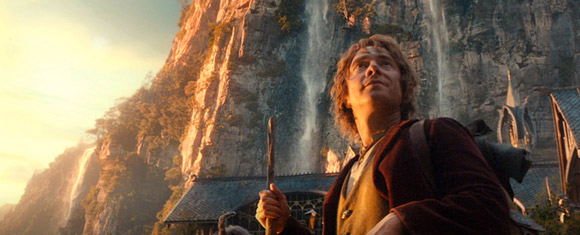I’m writing this having just finished watching The Hobbit HFR 3D and I’m still not sure how I feel about it. 48fps instead of the usual 24fps. I’d heard lots of negative comments about the high frame rate and so I was eager to see it for myself.
I have to say, my first reaction was the same as a lot of the comments I had heard. It looked cheap. It looked too real. It looked like a rehearsal or like watching a ‘making of’ documentary where it just looks normal and then you see the ‘afters’ where it looks like a film. This looked like the ‘befores’.
I remember Peter Jackson saying that it can be jarring when you first watch it but that you get used to it after about 8mins and after that you feel more immersed. All I know is that it totally pulled me out of the film initially. Possibly for the first hour. I was too aware. It looked in places like a low budget recreation about the Middle Ages. It looked like an old episode of Doctor Who.
The audio for some reason also didn’t sound great. I struggled to hear some actors. I was very aware of the score, or lack of score in some places. Perhaps this was due to the HFR pulling me out and just making me hyper aware of everything. And in film-making its about immersing the audiences and guiding their senses and emotions. But in HFR 3D it’s hard to hide anything. No more smoke and mirrors or distraction techniques. Everything is sharp and if it’s not spot on it looks fake.
But then a funny thing happened. I started to get more immersed in the second half of the film but I’m not quite sure why.
- Perhaps I was more gripped by the story and that distracted me, as a good story should
- Perhaps it was because there were a lot more visual effects in the second half of the film. They have more control over the lighting etc in the visual effects shots and therefore had a better chance of getting it right.
- Maybe it was because there were more bits in slow motion. Ironic that but it makes sense that the slower motion bits looked more smooth, although its also a bit strange having slow motion without any motion blur. It’s like the actors were just acting slow, like on ‘Who’s Line Is It Anyway’ or something. But it looked good
One thing I certainly noticed was that the lighting was very important. The bits that were mostly CGI looked stunning in HFR. The bits that looked most jarring were when they filmed against what were obviously sets (particular in the night scenes, interestingly). The lighting somehow just made it look too real and fake, (funny how in the movie business ‘real and fake’ isn’t always a contradiction in terms). When done well it was akin to the difference between standard definition and well shot hi definition. Stunning. But by the same token, and in the same way the early HD often looked very fake, it means you have to be very careful in how you light, apply make up and move the camera. Obviously this will mean that many people will do it badly. Even Peter Jackson didn’t get it right in every scene. And if a badly lit or badly shot scene is so easy to pull you out of the movie then I’m not sure it is something that everyone should try. I certainly wouldn’t want to see a drama or rom-com in HFR. Keep it to the fantasy and sci-fi adventures please. Or even better, nature documentaries and IMAX specials.
Like 3D, HFR has its dos and its dont’s. 3D has become overused and when used with too many fast cuts, like in most action films, it needs to be really dialled back or else it is jarring on the brain as the stereoscopic parallax keeps changing. HFR when used badly can be jarring as things look too sharp and you are pulled out. But I don’t think you can dial back HFR like you can with 3D. A film is either HFR or it isn’t.
But the bottom line is that it is great technology and personally I take my hat off to Mr Jackson for giving it a go. I do think it has a future but it just has to be used carefully and film makers have to know they are doing. It won’t become standard. Perhaps it’s best used for things like fully CGI sequences or longer shots like in nature documentaries. It should not be automatically used for every film. Exactly the same guidelines that 3D should have.
Sometimes 24fps is better. It adds that right amount of motion blur to give it a dreamlike quality and yet still hold persistence of vision. I read that when frame rate drops below 40fps we subconsciously know its not real and this lets us suspend disbelief. This is why 48fps can pull us out more easily and make us more aware of it being actors on a set. I would love to see The Hobbit side by side in both frame rates to do a direct comparison.
Now the big question. Would I opt to watch the next Hobbit movie in HFR or 24fps? To be honest I’m not 100% sure but I think I’d probably give HFR another go. When it’s done right it’s breathtaking.
Oh and by the way, Martin Freeman is fantastic in it.
Image source - www.thehobbit.com
